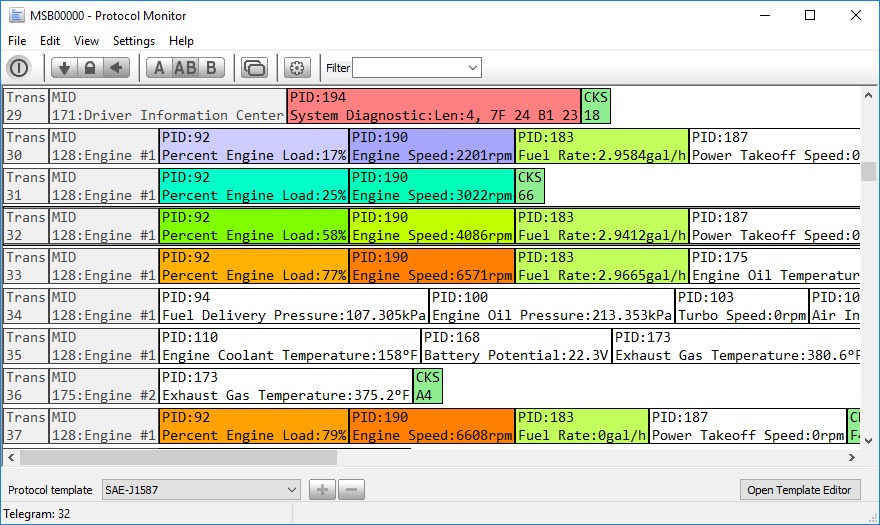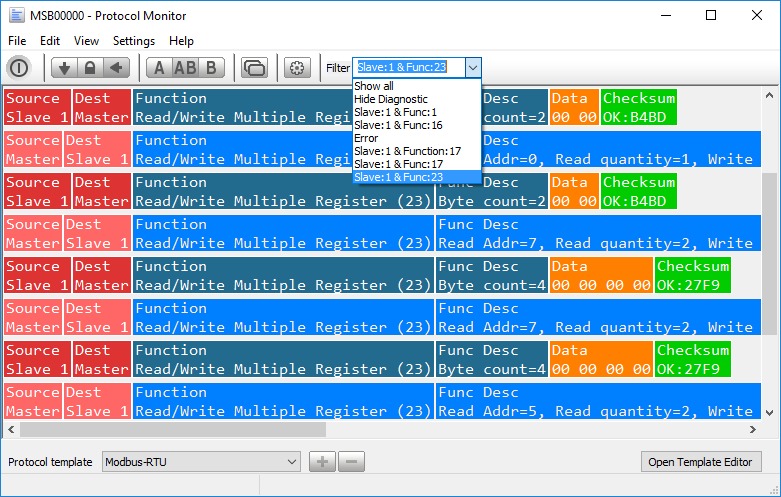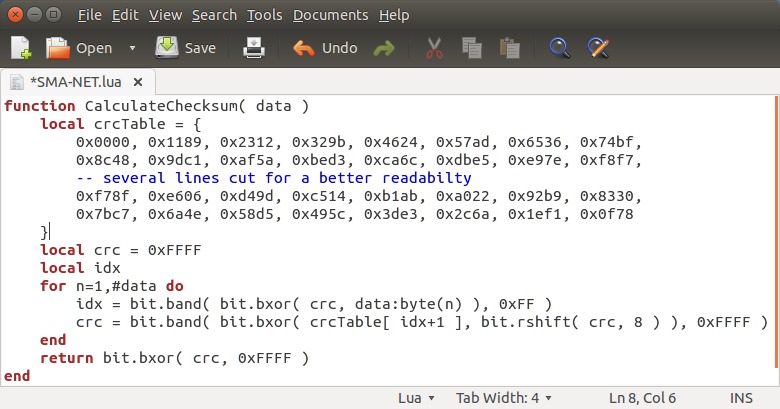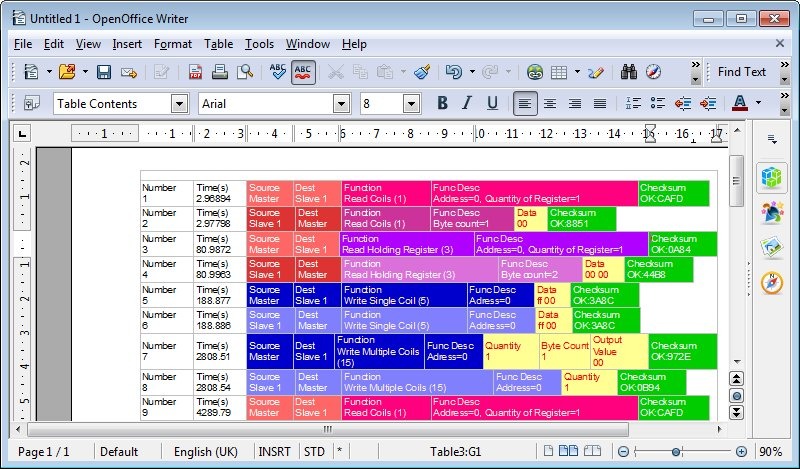Standards • Individuelle • Proprietäre
Was sind Templates?
Protokoll Templates sind Lua Skripts die vorgeben, wie ein kontinuierlicher Datenstrom in einzelne Telegramme unterteilt und wie diese dargestellt werden. Dies macht sie äußerst anpassbar an alle möglichen Protokolle.
Wie funktionieren sie?
Alle empfangenen Daten werden in einer extrem schnellen Lua Engine gemäß dem Template verarbeitet. Funktionen helfen die Start/Ende Bedingungen zu erkennen. Ein spezielles Box Modul erlaubt die individuelle Anzeige beliebiger Telegramm Abschnitte.
Eigene Templates?
Aber natürlich - das ist die Intention! Die Analyser Software bietet alles was Sie zum Schreiben eigener Templates benötigen. Oder Sie modifizieren eines der vielen mitgelieferten Templates ganz nach Ihren Zwecken. Mehr lesen
Meistern Sie Ihr Protokoll in allen Schichten

mit Features die Sie bei der Protokoll Analyse nicht vermissen wollen

Perfekt zur Ausbildung
Variieren Sie mit Lua die Protokoll Definitionen und sehen Sie die Auswirkungen unmittelbar im Display - ohne die aufgenommenen Daten zu beeinflussen.
Lesbare Telegramme
Verständliche statt kryptische Telegramm Inhalte! Umwandlung binären Zahlen, Zuweisung von eindeutigen Namen, veränderliche Farben abhängig vom Feldinhalt und mehr...
Individuelle Filter
Konzentrieren Sie Ihre Analyse auf die wichtigen Abschnitte indem sie eigene Filter realisieren. Sie entscheiden, welche Telegramme Sie sehen wollen.
Eigene Prüfsummen validieren
Berechnen, testen und verarbeiten auch individueller Prüfsummen. Verwenden Sie die integrierten Funktionen für CRC, LRC oder schreiben Sie Ihren eigenen Prüfsummen Algorithmus in Lua.
Vielfältiger Export
Dokumentieren Sie Ihre Resultate in Textverarbeitungs Programmen oder verarbeiteten Sie die Daten in Excel ®, Open Office Calc etc. Teilen Sie Ihre Ergebnisse mit anderen.BASE16 Decorder
Hex ASCII Sequenzen (z.B. Modbus ASCII) zu Binär
Zahlen Konverter
Little/Big Endian Datenbytes zu Integer oder Fliesskomma
Prüfsummen Validierer
CRC16 für Modbus, DNP3, CCiTT Kermit, BACnet, CRC8 BACnet, LRC
Datum & Zeit Ausgabe
Absolute, lokale und relative Anzeige von Zeit und Datum
Diverse Lua Erweiterungen
unterstützen Sie bei der Verarbeitung von unterschiedlich kodierten Daten wie z.B. Base16, Zahlen Umwandlung (little Endian, big Endian), Datum/Zeit Ausgabe und mehr...Verfügbare Templates
Die folgenden Templates sind bereits Teil der Analyser Software. Neu hinzukommende Templates können hier heruntergeladen werden.
- 3964(R)
-
Ein standardisiertes serielles Punkt-zu-Punkt-Protokoll, das üblicherweise zwischen zwei SPS verwendet wird (SPS). Es ist ein Master-Master-Protokoll und wird in zwei Varianten angeboten: 3964 ohne Prüfsumme und 3964R mit einer CRC-Prüfsumme. Der Analysator unterstützt beide.
- BACNet
-
Ein von ASHRAE, ANSI und ISO 16484-5 genormtes Vollduplex-Protokoll für Gebäudeautomations- und Steuerungsnetzwerke. Der Analysator unterstützt PTP (Point-To-Point) über RS-232 und MS/TP (Master-Slave/Token-Passing über RS-485).
- Common 9-Bit
-
Eine allgemeine Vorlage für Protokolle mit einem 9-Bit-Startfeld (Adresse). Sie kann als Start für typische Multi-Drop-Protokolle verwendet werden.
- DF-1
-
Das DF1-Protokoll von Allen-Bradley ist ein industrielles serielles Protokoll welches von einer großen Anzahl von Herstellern und Geräten unterstützt wird. Es unterstützt sowohl Vollduplex Peer-to-Peer als auch Halbduplex Master-Slave Kommunikationen.
- DNP3
-
DNP3 (Distributed Network Protocol) wird zwischen Komponenten im Bereich der Prozessautomatisierung eingesetzt, insbesondere bei Elektro- und Wasserbetrieben. Die Telegramme bestehen aus einem Header-Block fester Länge, gefolgt von optionalen Daten Blöcken. Jeder Block endet mit einer 16-Bit-CRC Prüfsumme.
- MDB/ICP
-
MDB/ICP ist ein serielles Busprotokoll für elektronisch gesteuerte Verkaufsautomaten. Ein Master steuert dabei mehrere Slaves wobei die Adresse des angesprochenen Slaves im ersten Byte als 9-Bit Wert kodiert ist.
- IEC60870-5-101
-
IEC 60870-5 bezieht sich auf eine Sammlung von IEC Normen, um einen offenen Standard für die Übertragung von SCADA-Telemetrie-Steuerungen und -Informationen bereitzustellen. Die Protokoll internen Einstellungen sehen eine unterschiedliche Informationsobjektadresse (IOA), eine unterschiedliche Länge der gemeinsamen Adresse (ASDU) und ein optionales Absenderfeld (COT) vor. Der Analysator unterstützt alle Varianten.
- Modbus
-
Modbus ist ein auf einem Multidrop-Netzwerk basierendes Kommunikationsprotokoll für eine Master/Client-Architektur. Ursprünglich 1979 von Modicon (jetzt Schneider Electric) veröffentlicht, hat es sich aufgrund seiner Einfachheit und Robustheit zu einem De-facto-Standard entwickelt. Serielle Modbus-Verbindungen können zwei grundlegende Übertragungsmodi verwenden: ASCII und RTU. Bei RTU werden die Telegramme durch einen spezifizierten Zeitabstand von 3,5 Zeichen getrennt. Die Analysatoren unterstützen beide.
- Profibus
-
Profibus ist ein Feldbus-Kommunikationsstandard, der erstmals 1989 vom deutschen Bundesministerium für Bildung und Forschung (BMBF) gefördert und dann von Siemens eingesetzt wurde. Ein Profibus-System verwendet einen Bus-Master zur zyklischen Abfrage von Slave-Geräten, die auf einem seriellen RS485-Bus im Multidrop-Verfahren verteilt sind. Die Slaves dürfen ohne Aufforderung durch den Master keine Daten senden. Wie bei Modbus werden die Telegramme durch eine spezifizierte Zeitlücke (Sende- oder Sync pause) von 33 Bit getrennt.
- SAE-J1587
-
SAE-J1587 ist eine von der Society of Automotive Engineers (SAE) entwickelte Norm für Kfz-Diagnoseprotokolle. Sie findet Anwendung bei schweren und den meisten mittelschweren Fahrzeuge, die nach 1985 gebaut wurden.
- SAE-J1922
-
Das SAE-J1922-Protokoll ist ein Standard für die Antriebsstrang-Steuerungsschnittstelle, die in mittelschweren und schweren Dieselfahrzeugen für den Straßenverkehr Anwendung finden.
Diese Vorlage wurde entwickelt, um die Kommunikation zwischen dem EM2000 und dem EMDEC auf einer SD70-Lokomotive zu analysieren. Die Hardware ist wahrscheinlich J1708 basierend auf RS485, jedoch ohne Abschlusswiderstände. Das Template selbst erhebt keinen Anspruch auf Vollständigkeit.
- SMA-NET
-
Das SMA-Net ist ein proprietäres Protokoll, das von SMA, einem der weltweit größten Hersteller von Photovoltaik-Wechselrichtern, entwickelt wurde. Es ist u.a. kompatibel mit TCP/IP, PPP und HDLC. Die Telegramme beginnen und enden mit dem Hexadezimalzeichen 7E, das beim Auftreten in den Nutzdaten entsprechend kodiert und dekodiert (Escape Character) werden muss.
- USS
-
Das USS-Protokoll (Universal Serial Interface Protocol) definiert ein Zugriffsverfahren nach dem Master-Slave-Prinzip für die Kommunikation über einen seriellen Bus. Es können ein Master und maximal 31 Slaves an den Bus angeschlossen werden. Die einzelnen Slaves werden vom Master über ein Adresszeichen im Telegramm ausgewählt.
Nicht dabei? - Selbst Schreiben!
Was wird benötigt
Jedes Template muss die zwei Funktionen split() und out() enthalten.
split() zerteilt den eingehenden Datenstrom in einzelne Telegrame.
out() kontrolliert die Erscheinung der aktuell sichtbaren Telegramme im Programm Fenster.
In Telegramme splitten
ist einfach. Jedes empfangene Byte wird mit allen nötigen Informationen an split() übergeben und bezüglich Telegramm Start oder Ende bewertet. Als Resultat wird STARTED, MODIFIED oder COMPLETED zurück gegeben. Beispiel ein/ausklappen!
Die Telegrammanzeige
wird in out() realisiert. Entworfen für maximale Performance wird out() nur für die Telegramme aufgerufen, die gerade angezeigt werden. In out() haben Sie Zugriff auf alle Telegramm Daten und können Sie individuell in farbigen Boxen darstellen. Beispiel ein/ausklappen!
Weitere Information
Mehr erfahren
Das umfassende Handbuch erklärt alle Aspekte des Schreibens von Template, einschließlich des Exports und Filterung individueller Protokolle.
Einfach ausprobieren
Laden Sie die Analyser Software herunter und 'spielen' Sie mit den enthaltenen Beispielen. Sie ist kostenlos und funktioniert auch ohne Analyser.
Brauchen Sie Hilfe?
Wir lieben neue Protokolle. Haben Sie ein hier nicht aufgeführtes Standard Protokoll? Geben Sie uns einfach Bescheid und wir schreiben es für Sie.
Empfohlene Tools
Wir werden oft gefragt, wie man Telegramme simuliert. Hier sind einige freie Tools die evtl. bereits eine Lösung versprechen.

